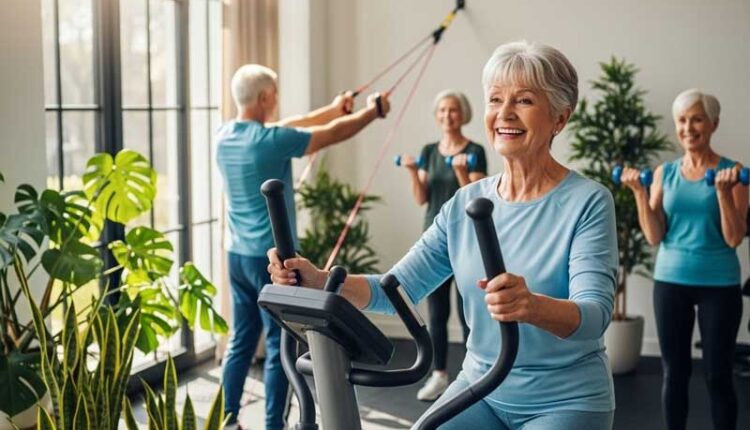Staying active becomes increasingly important as we age, but finding the right exercise solution can be challenging. That’s where home workout equipment for seniors comes in – offering a convenient, safe, and effective way to maintain physical health without leaving the comfort of your home. Whether you’re in your 60s, 70s, 80s, or beyond, the right equipment can make all the difference in maintaining strength, flexibility, and independence.
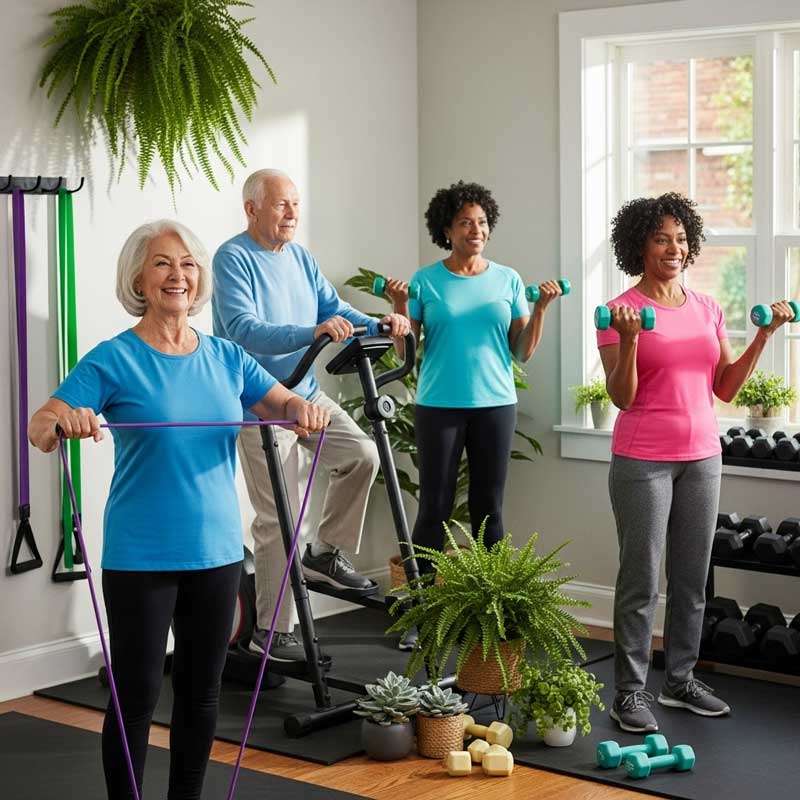
Why Home Workouts Are Ideal for Seniors
Let’s face it – heading to a gym isn’t always practical as we get older. The commute, crowded spaces, and intimidating atmosphere can deter even the most motivated individuals. Home workouts eliminate these barriers while providing privacy and comfort.
Did you know that regular exercise can reduce the risk of chronic diseases by up to 50% in older adults? With home workout equipment for seniors, you’re more likely to maintain consistency since your gym is just steps away. No more excuses about bad weather or traffic!
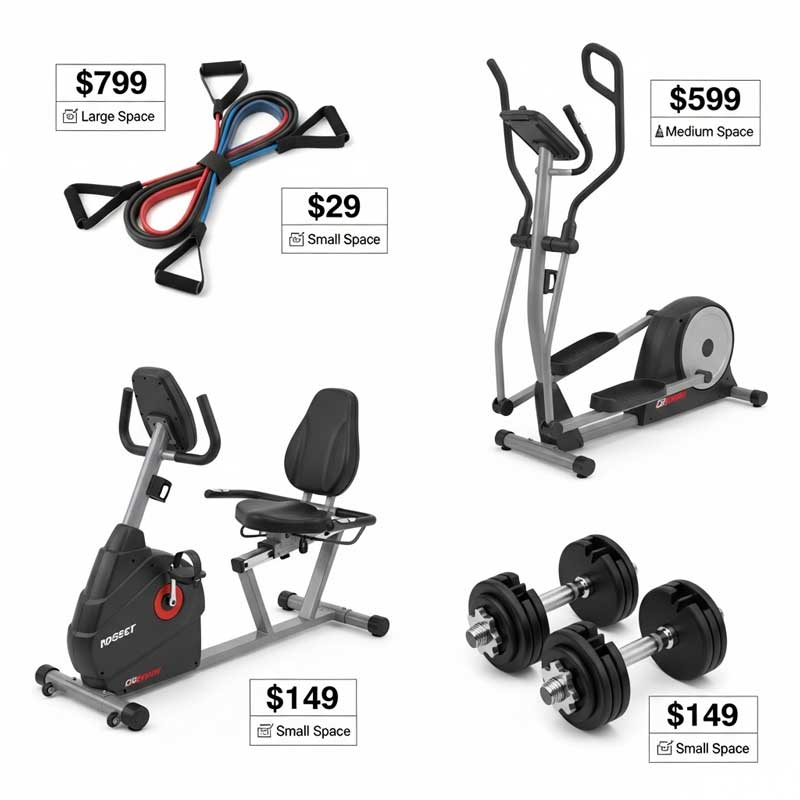
Best Exercise Equipment for Seniors at Home
When selecting equipment, it’s essential to consider your specific needs, space limitations, and fitness goals. The market offers numerous options designed specifically for older adults, focusing on safety, ease of use, and effectiveness.
- Low-impact cardio machines: Ellipticals, recumbent bikes, and treadmills with safety features
- Strength training tools: Adjustable dumbbells, resistance bands, and weight machines with light starting weights
- Balance and flexibility aids: Stability balls, yoga mats, and balance boards
- Specialized equipment: Seated exercise machines and hydraulic resistance systems
Exercise Equipment for Seniors Over 60
For those in their 60s who are generally active but want to maintain fitness at home, several excellent options exist. This age group often benefits from equipment that provides moderate challenges without excessive strain.
Stationary bikes and ellipticals offer fantastic cardiovascular benefits while being gentle on joints. Many models now come with advanced features like heart rate monitoring and pre-programmed workouts tailored to different fitness levels.
Now let’s get to strength training – adjustable dumbbells are perfect for this age group because they grow with your fitness level. Starting with lighter weights and gradually increasing as you build strength prevents injury while ensuring continuous progress. For those with limited space, dumbbells designed for small spaces offer the same benefits without cluttering your home.
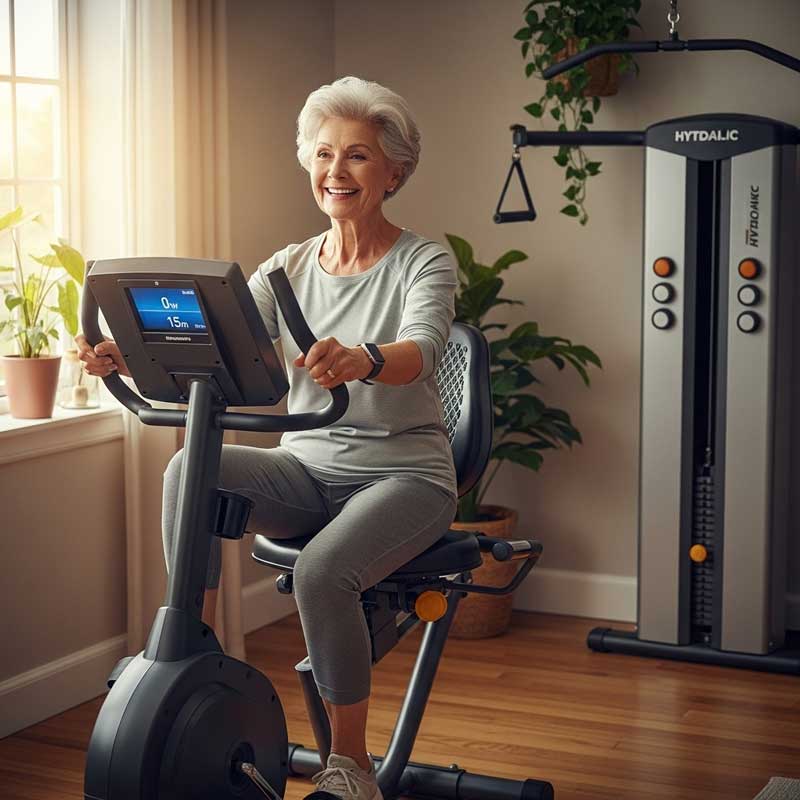
Exercise Equipment for Seniors Over 70
As we enter our 70s, safety becomes even more critical. Equipment with enhanced stability features and lower impact options takes priority. Recumbent stationary bikes are excellent choices because they provide back support and reduce stress on joints.
Hydraulic resistance machines are another fantastic option for this age group. Unlike traditional weight machines that use heavy plates, hydraulic systems use fluid resistance that’s smoother and easier on joints. These machines often have simple controls and comfortable seating, making them ideal for those with balance concerns.
Weight management remains important in our 70s to maintain overall health. Equipment designed for effective weight loss can help seniors maintain a healthy weight while building muscle mass, which naturally decreases with age.
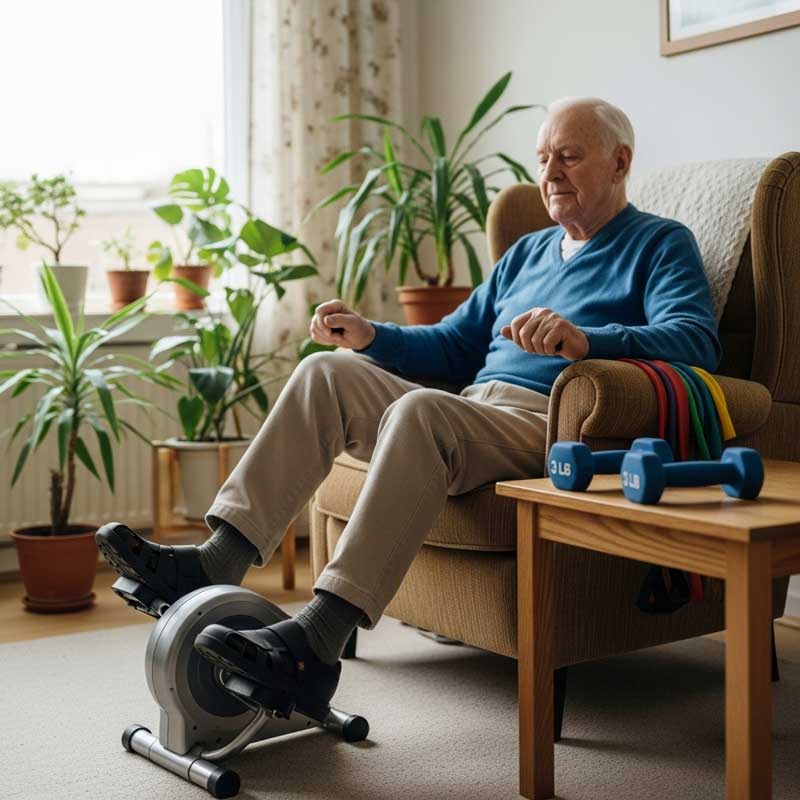
Exercise Equipment for Seniors Over 80
For those in their 80s and beyond, the focus shifts to maintaining functional independence and preventing falls. Equipment must be exceptionally safe, easy to use, and gentle on the body.
Pedal exercisers are perfect for this age group – they can be used while seated in a regular chair, allowing for gentle leg movement and improved circulation. Similarly, resistance bands for beginners offer a safe way to maintain upper body strength without the risk of dropping weights.
Light hand weights (1-3 pounds) can help maintain arm strength for daily activities like carrying groceries or lifting household items. The key is consistency rather than intensity at this age.
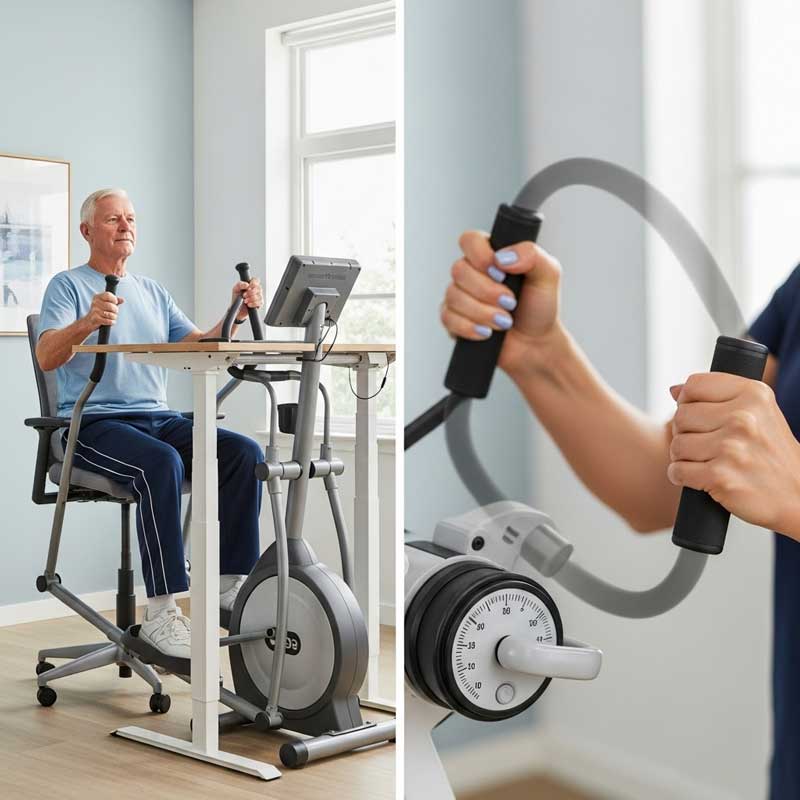
Best Sitting Exercise Machine for Elderly
For seniors with significant mobility challenges or balance issues, seated exercise equipment provides a safe solution to stay active. These machines allow you to get cardiovascular and strength benefits while remaining comfortably seated.
Seated ellipticals and steppers are excellent options that simulate walking or climbing motions without putting pressure on joints. They typically feature adjustable resistance levels and can be placed under a desk or in front of a chair for easy use.
Arm ergometers (arm bikes) focus on upper body strength and cardiovascular health. They’re particularly beneficial for those who cannot use their legs for exercise due to injury, arthritis, or other conditions.
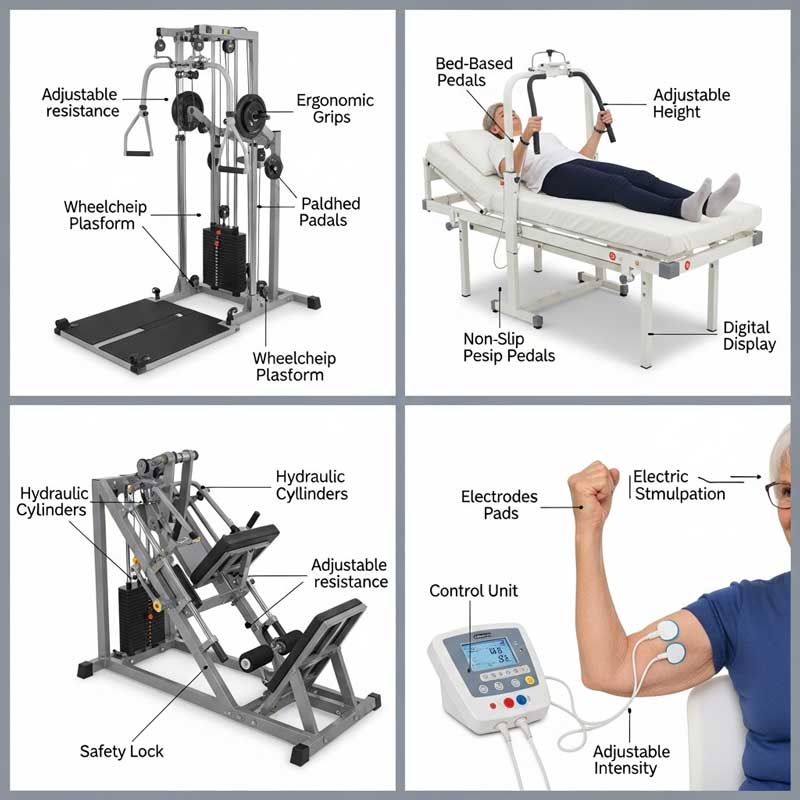
Exercise Equipment for Seniors with Limited Mobility
Limited mobility doesn’t mean giving up on exercise. In fact, staying active becomes even more crucial to prevent further deterioration of physical function. Several innovative equipment options cater specifically to this need:
- Wheelchair-accessible equipment: Machines designed to accommodate wheelchairs
- Bed-based exercise systems: For those with severe mobility limitations
- Hydraulic resistance machines: Offer smooth, controlled movements without heavy weights
- Electric stimulation units: Help activate muscles that might be difficult to engage voluntarily
These specialized tools can make a tremendous difference in maintaining circulation, muscle tone, and overall health for those with significant physical limitations.
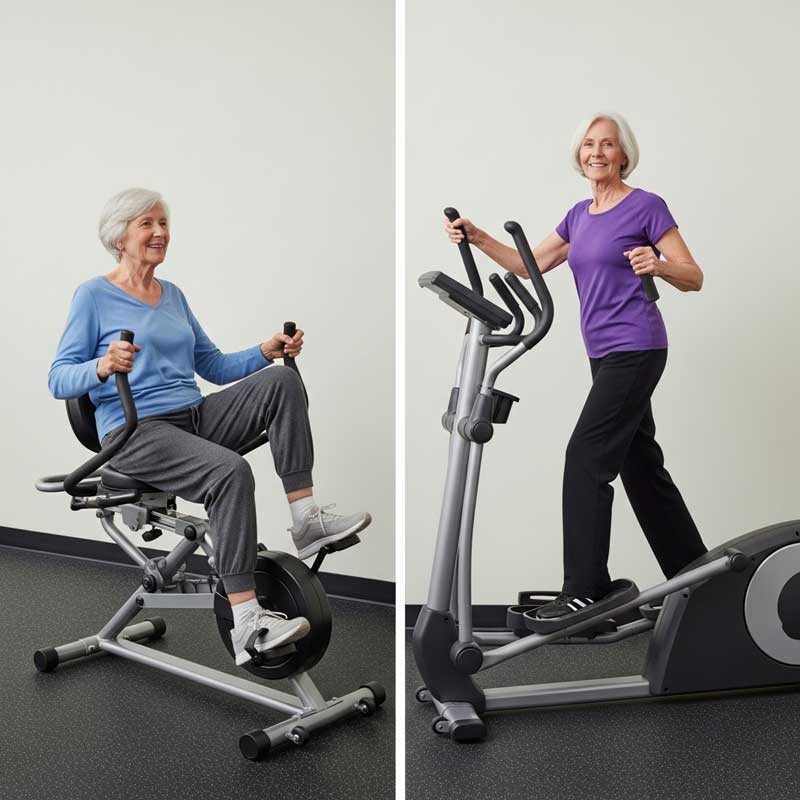
Exercise Equipment for Seniors with Arthritis
Arthritis can make exercise challenging, but staying active is one of the best ways to manage arthritis symptoms. The key is choosing equipment that minimizes joint stress while still providing effective workouts.
Warm water exercise is ideal for arthritis, but not everyone has access to a pool. Fortunately, several land-based options work well:
- Recumbent steppers: Reduce knee and hip stress while providing cardiovascular benefits
- Ellipticals with low incline settings: Offer smooth, gliding motions that are gentle on joints
- Resistance bands: Allow for strength training with minimal joint compression
The best approach is to start slowly and gradually increase duration and intensity as your joints adapt. Always listen to your body and avoid movements that cause sharp pain.
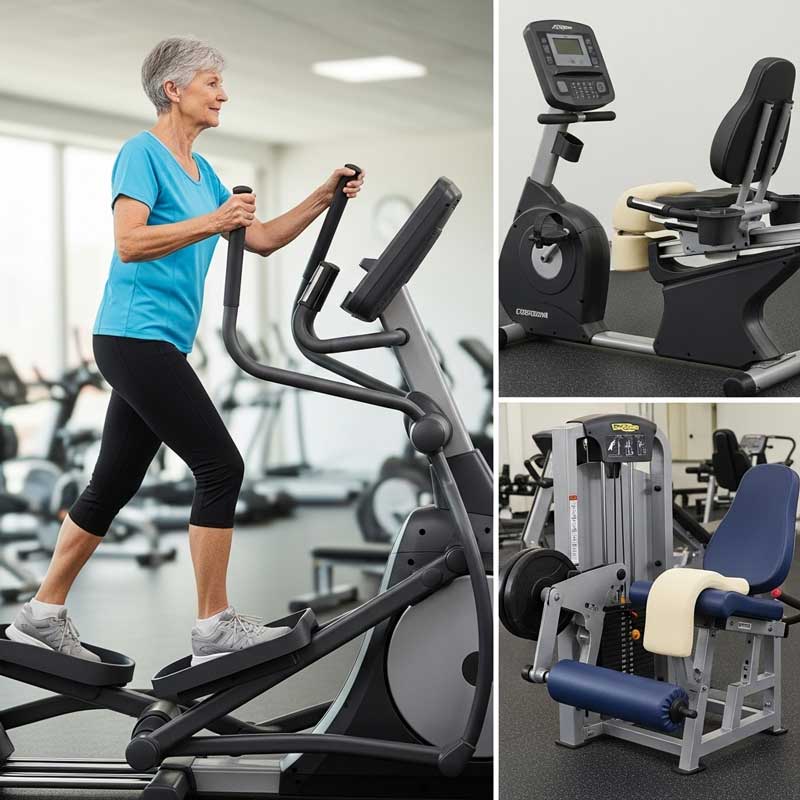
Exercise Equipment for Seniors with Bad Knees
Knee problems are common among seniors, but they don’t have to derail your fitness routine. The right equipment can help you strengthen the muscles around your knees while minimizing stress on the joint itself.
Ellipticals are often superior to treadmills for those with knee issues because they provide a smooth, gliding motion without impact. The foot pedals on ellipticals support your body weight, reducing pressure on your knees.
Recumbent bikes are another excellent choice as they position your body to reduce knee strain while still providing an effective cardiovascular workout. For strength training, leg extension machines with light weights can help strengthen the quadriceps muscles that support the knee joint.
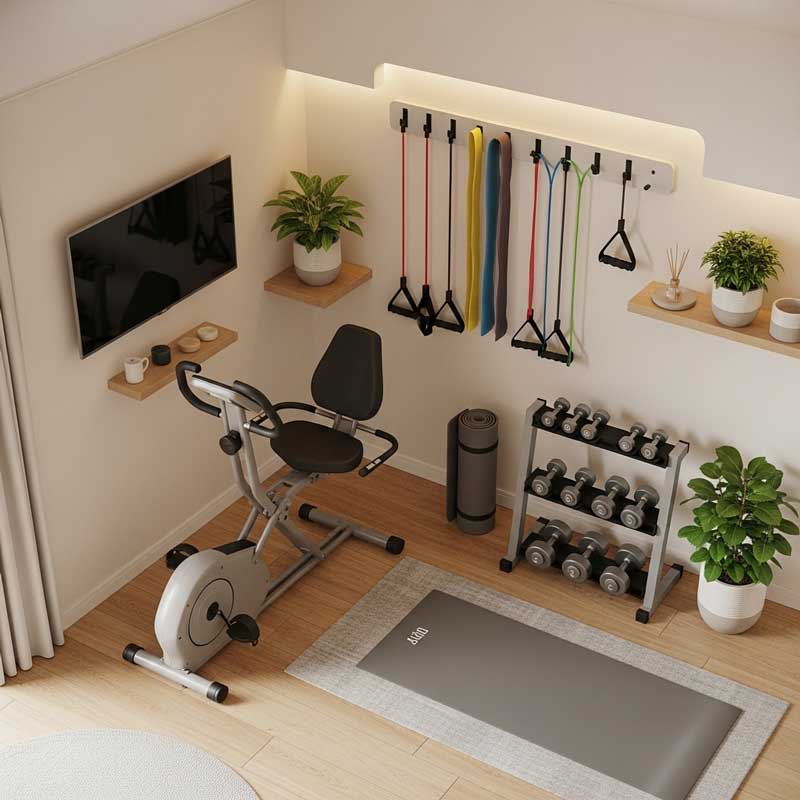
Creating Your Senior-Friendly Home Gym
Setting up a home gym doesn’t require a massive space or fortune. With careful planning, you can create an effective workout area that meets your needs:
- Assess your space: Even a corner of a room can work for basic equipment
- Prioritize safety: Ensure proper flooring, good lighting, and adequate clearance
- Start with essentials: Begin with 2-3 versatile pieces of equipment
- Consider storage: Look for foldable or compact options if space is limited
- Make it inviting: Add a TV, music player, or comfortable seating area
For comprehensive guidance on setting up your home gym, check out this resource on home gym equipment that covers everything from basic setups to advanced configurations.
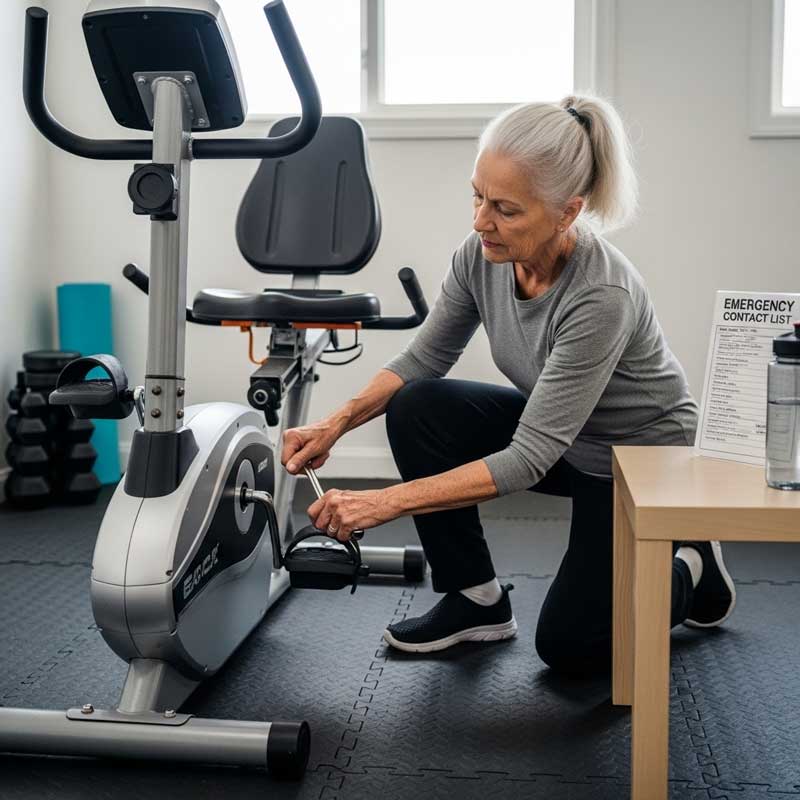
Safety Tips for Senior Home Workouts
Safety should always be your top priority when exercising at home. These essential precautions will help you avoid injury:
- Always warm up before exercising and cool down afterward
- Stay hydrated before, during, and after workouts
- Wear proper footwear with good support
- Keep emergency contact information accessible
- Exercise with a buddy when possible, or let someone know your workout schedule
- Listen to your body and stop immediately if you feel pain, dizziness, or shortness of breath
- Keep equipment well-maintained and check for wear regularly
Really, taking these simple precautions can make the difference between a beneficial workout and an unfortunate injury. Your health is worth that extra attention to safety!
Sample Workout Routines for Seniors
Having equipment is only half the battle – knowing how to use it effectively is equally important. Here are three sample workout routines tailored for different fitness levels:
Beginner Routine (3 days/week)
- 5-minute warm-up (marching in place or gentle stretching)
- 10 minutes on recumbent bike (light resistance)
- 2 sets of 10 repetitions with light dumbbells (seated bicep curls, overhead presses)
- 5 minutes of stretching
- 5-minute cool-down
Intermediate Routine (4 days/week)
- 5-minute warm-up
- 15 minutes on elliptical (moderate resistance)
- 3 sets of 12 repetitions with moderate dumbbells (various upper body exercises)
- 10 minutes of resistance band exercises (lower body focus)
- 5 minutes of stretching
- 5-minute cool-down
Advanced Routine (5 days/week)
- 5-minute warm-up
- 20 minutes on treadmill or elliptical (challenging but sustainable pace)
- 3 sets of 15 repetitions with challenging dumbbells
- 10 minutes of core exercises
- 10 minutes of flexibility work
- 5-minute cool-down
Remember to alternate between cardio and strength days if exercising five times weekly, allowing for adequate recovery.
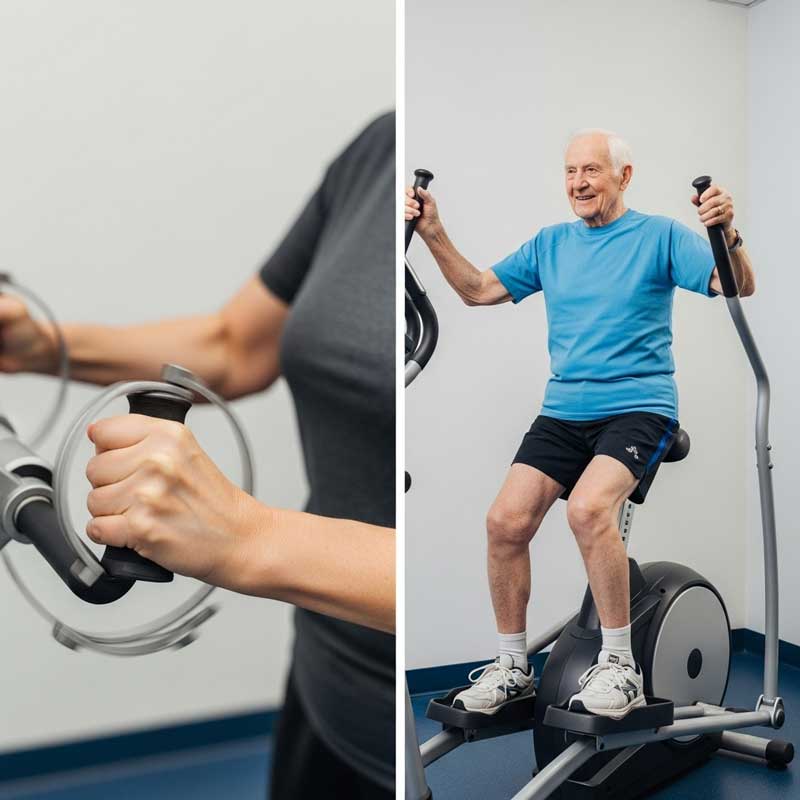
Maintenance and Care of Your Equipment
Proper maintenance ensures your equipment lasts longer and functions safely. Follow these guidelines:
- Wipe down equipment after each use to prevent sweat damage
- Check moving parts regularly for signs of wear
- Tighten bolts and screws monthly
- Lubricate mechanical parts as recommended by the manufacturer
- Store equipment properly when not in use
- Follow manufacturer guidelines for professional servicing
Did you even think about how much more enjoyable your workouts would be with well-maintained equipment? It’s worth the effort!
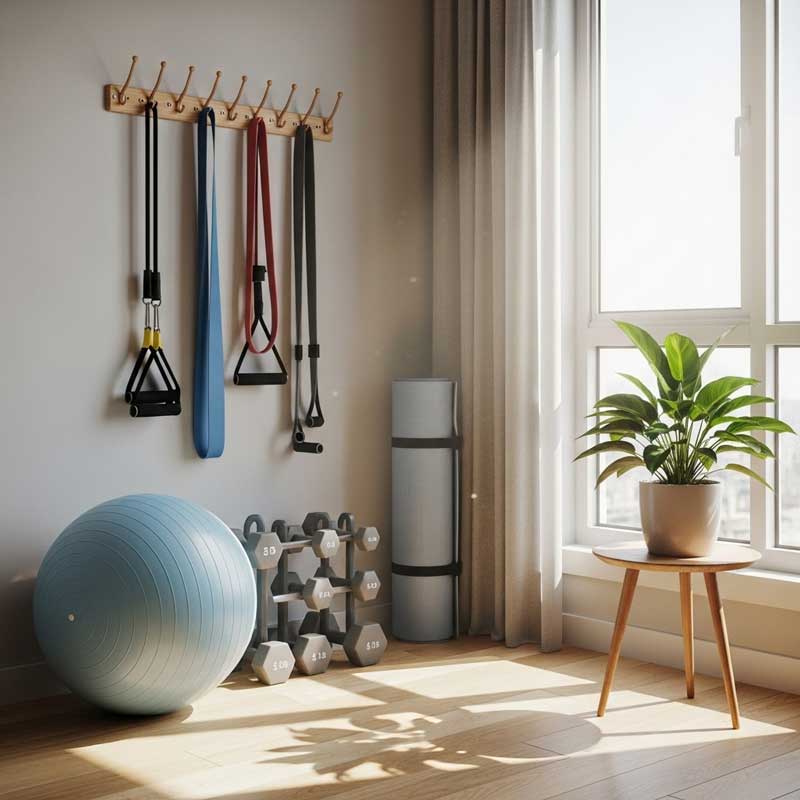
Budget-Friendly Options for Senior Home Gyms
You don’t need to break the bank to create an effective home gym. Many affordable options provide excellent results:
- Resistance bands: Under $20 for a set with varying resistance levels
- Stability ball: $15-$30 for core strength and balance work
- Light dumbbells: $1-$2 per pound
- Step platform: $30-$60 for cardiovascular workouts
- Yoga mat: $15-$40 for floor exercises and stretching
Many of these items are versatile and can be used for multiple exercises, maximizing your investment. Additionally, consider second-hand equipment from reputable sources – many people sell barely used machines at a fraction of the original cost.
The Mental Health Benefits of Home Exercise
While we often focus on physical benefits, the mental health advantages of regular exercise are equally significant, especially for seniors. Home workouts can:
- Reduce symptoms of depression and anxiety
- Improve sleep quality
- Enhance cognitive function and memory
- Boost self-esteem and confidence
- Provide a sense of accomplishment and purpose
The convenience of home workout equipment for seniors means you’re more likely to stick with your routine, maximizing these mental health benefits over time.
Conclusion: Embracing Active Aging at Home
Investing in home workout equipment for seniors is one of the best decisions you can make for your long-term health and independence. The right equipment allows you to exercise safely, conveniently, and effectively regardless of your age or physical limitations.
Remember that consistency matters more than intensity – even short daily workouts can yield significant benefits over time. Start where you are, use appropriate equipment for your needs, and gradually increase your activity level as your fitness improves.
We’d love to hear about your experiences with home workout equipment! What’s worked well for you? What challenges have you faced? Please leave a comment below to share your thoughts and questions.
If you found this article helpful, consider sharing it with friends or family members who might benefit from this information. And be sure to explore our other articles on senior fitness, nutrition, and wellness for more tips on living your best life in your golden years!
Frequently Asked Questions
What is the best exercise machine for seniors at home?
The best exercise machine depends on individual needs, but recumbent stationary bikes and ellipticals are generally excellent choices for most seniors. They provide cardiovascular benefits with minimal joint stress, offer adjustable resistance levels, and come with safety features like stable frames and easy-to-use controls. For those with balance issues, seated options like recumbent bikes are particularly recommended.
What is the best piece of home gym equipment for over 50s?
For those over 50, adjustable dumbbells are often the most versatile and valuable piece of equipment. They allow for a wide range of strength training exercises, take up minimal space, and can be adjusted as your fitness level improves. Combined with a good quality yoga mat for floor exercises and stretching, adjustable dumbbells provide a solid foundation for a comprehensive home fitness routine.
Which is better for seniors, a treadmill or an elliptical?
For most seniors, an elliptical is generally better than a treadmill because it provides a low-impact cardiovascular workout that’s easier on the joints. Ellipticals simulate walking or running motions without the impact that can stress knees, hips, and ankles. However, treadmills with excellent cushioning and handrails can be appropriate for active seniors without significant joint issues. The choice ultimately depends on your specific health conditions and fitness goals.
What equipment is best for abs?
For seniors looking to strengthen their core muscles, stability balls are excellent tools. They allow for safe abdominal exercises that can be modified for different fitness levels. Resistance bands can also be effective for core work when used for exercises like standing rotations or seated abdominal crunches. For those with back concerns, seated ab machines that provide support while targeting the abdominal muscles are a safe option. Always prioritize proper form over intensity when working on core strength.
Staying active becomes increasingly important as we age, but finding the right exercise solution can be challenging. That’s where home workout equipment for seniors comes in – offering a convenient, safe, and effective way to maintain physical health without leaving the comfort of your home. Whether you’re in your 60s, 70s, 80s, or beyond, the right equipment can make all the difference in maintaining strength, flexibility, and independence.
Why Home Workouts Are Ideal for Seniors
Let’s face it – heading to a gym isn’t always practical as we get older. The commute, crowded spaces, and intimidating atmosphere can deter even the most motivated individuals. Home workouts eliminate these barriers while providing privacy and comfort.
Did you know that regular exercise can reduce the risk of chronic diseases by up to 50% in older adults? With home workout equipment for seniors, you’re more likely to maintain consistency since your gym is just steps away. No more excuses about bad weather or traffic!
Best Exercise Equipment for Seniors at Home
When selecting equipment, it’s essential to consider your specific needs, space limitations, and fitness goals. The market offers numerous options designed specifically for older adults, focusing on safety, ease of use, and effectiveness.
- Low-impact cardio machines: Ellipticals, recumbent bikes, and treadmills with safety features
- Strength training tools: Adjustable dumbbells, resistance bands, and weight machines with light starting weights
- Balance and flexibility aids: Stability balls, yoga mats, and balance boards
- Specialized equipment: Seated exercise machines and hydraulic resistance systems
Exercise Equipment for Seniors Over 60
For those in their 60s who are generally active but want to maintain fitness at home, several excellent options exist. This age group often benefits from equipment that provides moderate challenges without excessive strain.
Stationary bikes and ellipticals offer fantastic cardiovascular benefits while being gentle on joints. Many models now come with advanced features like heart rate monitoring and pre-programmed workouts tailored to different fitness levels.
Now let’s get to strength training – adjustable dumbbells are perfect for this age group because they grow with your fitness level. Starting with lighter weights and gradually increasing as you build strength prevents injury while ensuring continuous progress. For those with limited space, dumbbells designed for small spaces offer the same benefits without cluttering your home.
Exercise Equipment for Seniors Over 70
As we enter our 70s, safety becomes even more critical. Equipment with enhanced stability features and lower impact options takes priority. Recumbent stationary bikes are excellent choices because they provide back support and reduce stress on joints.
Hydraulic resistance machines are another fantastic option for this age group. Unlike traditional weight machines that use heavy plates, hydraulic systems use fluid resistance that’s smoother and easier on joints. These machines often have simple controls and comfortable seating, making them ideal for those with balance concerns.
Weight management remains important in our 70s to maintain overall health. Equipment designed for effective weight loss can help seniors maintain a healthy weight while building muscle mass, which naturally decreases with age.
Exercise Equipment for Seniors Over 80
For those in their 80s and beyond, the focus shifts to maintaining functional independence and preventing falls. Equipment must be exceptionally safe, easy to use, and gentle on the body.
Pedal exercisers are perfect for this age group – they can be used while seated in a regular chair, allowing for gentle leg movement and improved circulation. Similarly, resistance bands for beginners offer a safe way to maintain upper body strength without the risk of dropping weights.
Light hand weights (1-3 pounds) can help maintain arm strength for daily activities like carrying groceries or lifting household items. The key is consistency rather than intensity at this age.
Best Sitting Exercise Machine for Elderly
For seniors with significant mobility challenges or balance issues, seated exercise equipment provides a safe solution to stay active. These machines allow you to get cardiovascular and strength benefits while remaining comfortably seated.
Seated ellipticals and steppers are excellent options that simulate walking or climbing motions without putting pressure on joints. They typically feature adjustable resistance levels and can be placed under a desk or in front of a chair for easy use.
Arm ergometers (arm bikes) focus on upper body strength and cardiovascular health. They’re particularly beneficial for those who cannot use their legs for exercise due to injury, arthritis, or other conditions.
Exercise Equipment for Seniors with Limited Mobility
Limited mobility doesn’t mean giving up on exercise. In fact, staying active becomes even more crucial to prevent further deterioration of physical function. Several innovative equipment options cater specifically to this need:
- Wheelchair-accessible equipment: Machines designed to accommodate wheelchairs
- Bed-based exercise systems: For those with severe mobility limitations
- Hydraulic resistance machines: Offer smooth, controlled movements without heavy weights
- Electric stimulation units: Help activate muscles that might be difficult to engage voluntarily
These specialized tools can make a tremendous difference in maintaining circulation, muscle tone, and overall health for those with significant physical limitations.
Exercise Equipment for Seniors with Arthritis
Arthritis can make exercise challenging, but staying active is one of the best ways to manage arthritis symptoms. The key is choosing equipment that minimizes joint stress while still providing effective workouts.
Warm water exercise is ideal for arthritis, but not everyone has access to a pool. Fortunately, several land-based options work well:
- Recumbent steppers: Reduce knee and hip stress while providing cardiovascular benefits
- Ellipticals with low incline settings: Offer smooth, gliding motions that are gentle on joints
- Resistance bands: Allow for strength training with minimal joint compression
The best approach is to start slowly and gradually increase duration and intensity as your joints adapt. Always listen to your body and avoid movements that cause sharp pain.
Exercise Equipment for Seniors with Bad Knees
Knee problems are common among seniors, but they don’t have to derail your fitness routine. The right equipment can help you strengthen the muscles around your knees while minimizing stress on the joint itself.
Ellipticals are often superior to treadmills for those with knee issues because they provide a smooth, gliding motion without impact. The foot pedals on ellipticals support your body weight, reducing pressure on your knees.
Recumbent bikes are another excellent choice as they position your body to reduce knee strain while still providing an effective cardiovascular workout. For strength training, leg extension machines with light weights can help strengthen the quadriceps muscles that support the knee joint.
Creating Your Senior-Friendly Home Gym
Setting up a home gym doesn’t require a massive space or fortune. With careful planning, you can create an effective workout area that meets your needs:
- Assess your space: Even a corner of a room can work for basic equipment
- Prioritize safety: Ensure proper flooring, good lighting, and adequate clearance
- Start with essentials: Begin with 2-3 versatile pieces of equipment
- Consider storage: Look for foldable or compact options if space is limited
- Make it inviting: Add a TV, music player, or comfortable seating area
For comprehensive guidance on setting up your home gym, check out this resource on home gym equipment that covers everything from basic setups to advanced configurations.
Safety Tips for Senior Home Workouts
Safety should always be your top priority when exercising at home. These essential precautions will help you avoid injury:
- Always warm up before exercising and cool down afterward
- Stay hydrated before, during, and after workouts
- Wear proper footwear with good support
- Keep emergency contact information accessible
- Exercise with a buddy when possible, or let someone know your workout schedule
- Listen to your body and stop immediately if you feel pain, dizziness, or shortness of breath
- Keep equipment well-maintained and check for wear regularly
Really, taking these simple precautions can make the difference between a beneficial workout and an unfortunate injury. Your health is worth that extra attention to safety!
Sample Workout Routines for Seniors
Having equipment is only half the battle – knowing how to use it effectively is equally important. Here are three sample workout routines tailored for different fitness levels:
Beginner Routine (3 days/week)
- 5-minute warm-up (marching in place or gentle stretching)
- 10 minutes on recumbent bike (light resistance)
- 2 sets of 10 repetitions with light dumbbells (seated bicep curls, overhead presses)
- 5 minutes of stretching
- 5-minute cool-down
Intermediate Routine (4 days/week)
- 5-minute warm-up
- 15 minutes on elliptical (moderate resistance)
- 3 sets of 12 repetitions with moderate dumbbells (various upper body exercises)
- 10 minutes of resistance band exercises (lower body focus)
- 5 minutes of stretching
- 5-minute cool-down
Advanced Routine (5 days/week)
- 5-minute warm-up
- 20 minutes on treadmill or elliptical (challenging but sustainable pace)
- 3 sets of 15 repetitions with challenging dumbbells
- 10 minutes of core exercises
- 10 minutes of flexibility work
- 5-minute cool-down
Remember to alternate between cardio and strength days if exercising five times weekly, allowing for adequate recovery.
Maintenance and Care of Your Equipment
Proper maintenance ensures your equipment lasts longer and functions safely. Follow these guidelines:
- Wipe down equipment after each use to prevent sweat damage
- Check moving parts regularly for signs of wear
- Tighten bolts and screws monthly
- Lubricate mechanical parts as recommended by the manufacturer
- Store equipment properly when not in use
- Follow manufacturer guidelines for professional servicing
Did you even think about how much more enjoyable your workouts would be with well-maintained equipment? It’s worth the effort!
Budget-Friendly Options for Senior Home Gyms
You don’t need to break the bank to create an effective home gym. Many affordable options provide excellent results:
- Resistance bands: Under $20 for a set with varying resistance levels
- Stability ball: $15-$30 for core strength and balance work
- Light dumbbells: $1-$2 per pound
- Step platform: $30-$60 for cardiovascular workouts
- Yoga mat: $15-$40 for floor exercises and stretching
Many of these items are versatile and can be used for multiple exercises, maximizing your investment. Additionally, consider second-hand equipment from reputable sources – many people sell barely used machines at a fraction of the original cost.
The Mental Health Benefits of Home Exercise
While we often focus on physical benefits, the mental health advantages of regular exercise are equally significant, especially for seniors. Home workouts can:
- Reduce symptoms of depression and anxiety
- Improve sleep quality
- Enhance cognitive function and memory
- Boost self-esteem and confidence
- Provide a sense of accomplishment and purpose
The convenience of home workout equipment for seniors means you’re more likely to stick with your routine, maximizing these mental health benefits over time.
Conclusion: Embracing Active Aging at Home
Investing in home workout equipment for seniors is one of the best decisions you can make for your long-term health and independence. The right equipment allows you to exercise safely, conveniently, and effectively regardless of your age or physical limitations.
Remember that consistency matters more than intensity – even short daily workouts can yield significant benefits over time. Start where you are, use appropriate equipment for your needs, and gradually increase your activity level as your fitness improves.
We’d love to hear about your experiences with home workout equipment! What’s worked well for you? What challenges have you faced? Please leave a comment below to share your thoughts and questions.
If you found this article helpful, consider sharing it with friends or family members who might benefit from this information. And be sure to explore our other articles on senior fitness, nutrition, and wellness for more tips on living your best life in your golden years!
Frequently Asked Questions
What is the best exercise machine for seniors at home?
The best exercise machine depends on individual needs, but recumbent stationary bikes and ellipticals are generally excellent choices for most seniors. They provide cardiovascular benefits with minimal joint stress, offer adjustable resistance levels, and come with safety features like stable frames and easy-to-use controls. For those with balance issues, seated options like recumbent bikes are particularly recommended.
What is the best piece of home gym equipment for over 50s?
For those over 50, adjustable dumbbells are often the most versatile and valuable piece of equipment. They allow for a wide range of strength training exercises, take up minimal space, and can be adjusted as your fitness level improves. Combined with a good quality yoga mat for floor exercises and stretching, adjustable dumbbells provide a solid foundation for a comprehensive home fitness routine.
Which is better for seniors, a treadmill or an elliptical?
For most seniors, an elliptical is generally better than a treadmill because it provides a low-impact cardiovascular workout that’s easier on the joints. Ellipticals simulate walking or running motions without the impact that can stress knees, hips, and ankles. However, treadmills with excellent cushioning and handrails can be appropriate for active seniors without significant joint issues. The choice ultimately depends on your specific health conditions and fitness goals.
What equipment is best for abs?
For seniors looking to strengthen their core muscles, stability balls are excellent tools. They allow for safe abdominal exercises that can be modified for different fitness levels. Resistance bands can also be effective for core work when used for exercises like standing rotations or seated abdominal crunches. For those with back concerns, seated ab machines that provide support while targeting the abdominal muscles are a safe option. Always prioritize proper form over intensity when working on core strength.

